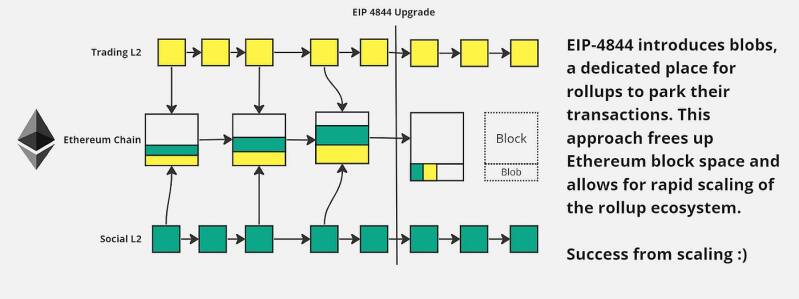
In the fast-paced world of blockchain technology, the pursuit of scalability and sustainability remains a paramount concern. Ethereum Improvement Proposal 4844 (EIP-4844) emerges as a beacon of innovation, offering a nuanced approach to address these critical challenges. In this blog post, we delve into the intricacies of EIP-4844 and its implications for the future of blockchain.
Understanding EIP-4844:
EIP-4844 proposes a consensus mechanism known as Proof-of-Hybrid-Stake (PoHS), aiming to strike a delicate balance between scalability and sustainability. Unlike traditional proof-of-work (PoW) or proof-of-stake (PoS) mechanisms, PoHS integrates elements of both approaches, leveraging the strengths of each while mitigating their respective weaknesses.
Scalability:
One of the primary objectives of EIP-4844 is to enhance blockchain scalability. By incorporating PoS-like characteristics, such as efficient block validation and reduced energy consumption, the proposed consensus mechanism lays the groundwork for accommodating a higher transaction throughput without compromising network security.
Sustainability:
In an era marked by growing concerns over the environmental impact of blockchain technology, EIP-4844 offers a ray of hope. Through its hybrid approach, the proposal strives to minimize energy consumption by transitioning away from resource-intensive PoW mining towards an eco-friendlier consensus model. This shift not only aligns with broader sustainability goals but also fosters greater social acceptance of blockchain technology.
Technical Implementation:
EIP-4844 introduces several technical innovations to realize its ambitious goals. Key components include a dynamic block size mechanism to adapt to network demand, a weighted validator selection algorithm to ensure fair participation, and a robust slashing mechanism to deter malicious actors. Together, these elements form the foundation of a resilient and scalable blockchain ecosystem.
Why EIP-4844 Matters
Ethereum's current scalability limitations are largely due to the high cost of data availability. Every transaction on Ethereum requires data to be stored and verified across all nodes in the network, leading to increased costs and slower processing times as the network grows. This is where EIP-4844 increases value.
1. Lower Data Costs
Blobs introduced by EIP-4844 are specifically designed to make data availability cheaper. Since these blobs can store large amounts of data in a compact format, they allow rollups to post data to the Ethereum main net more efficiently. This reduction in data costs directly translates to lower gas fees for users, making Ethereum more affordable and accessible.
2. Enabling Layer 2 Solutions
Layer 2 solutions like rollups are crucial for scaling Ethereum. They work by processing transactions off-chain and only posting the final data back to the Ethereum mainnet. However, the cost of posting this data has been a major bottleneck. By introducing blobs, EIP-4844 makes it easier and cheaper for rollups to function, paving the way for wider adoption and usage of Layer 2 technologies.
3. Proto-Danksharding: The Future of Ethereum
EIP-4844 is also often referred to as Proto-Danksharding because it is seen as a precursor to a more advanced scaling solution called Danksharding. Danksharding aims to dramatically increase Ethereum’s scalability by breaking the network into smaller pieces, or "shards," each capable of processing its own transactions. While full Danksharding is still in development, EIP-4844 lays the groundwork by introducing some of the essential components needed for this future upgrade.
Implications for the Future:
The adoption of EIP-4844 has far-reaching implications for the future of blockchain technology. By addressing scalability and sustainability concerns simultaneously, the proposal paves the way for broader mainstream adoption and unlocks new possibilities for decentralized applications (dApps), decentralized finance (DeFi), and beyond. Moreover, its flexible design ensures adaptability to evolving technological and environmental landscapes, ensuring long-term viability and relevance.



Reactie plaatsen
Reacties